The NVIDIA GeForce GTX Titan X Review
by Ryan Smith on March 17, 2015 3:00 PM ESTMiddle Earth: Shadow of Mordor
Our next benchmark is Monolith’s popular open-world action game, Middle Earth: Shadow of Mordor. One of our current-gen console multiplatform titles, Shadow of Mordor is plenty punishing on its own, and at Ultra settings it absolutely devours VRAM, showcasing the knock-on effect of current-gen consoles have on VRAM requirements.
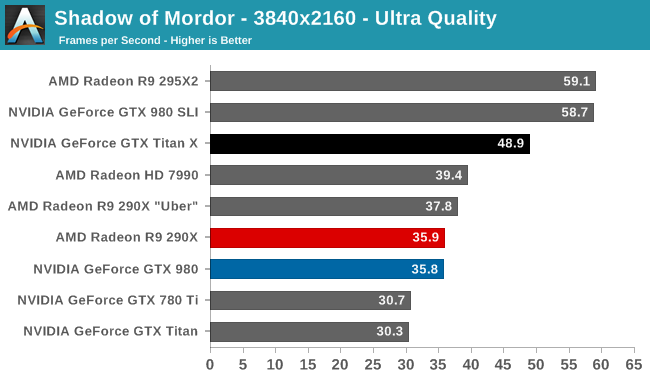
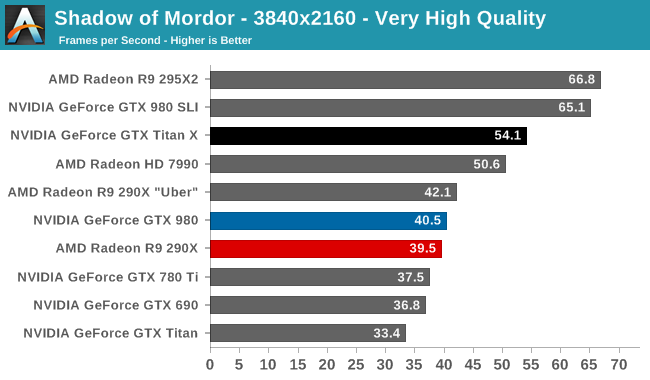
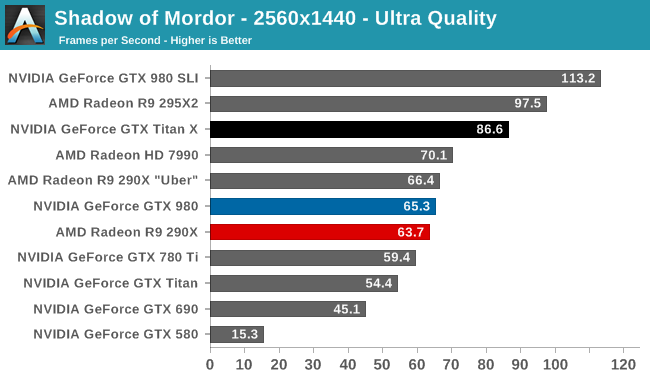
Once again even GTX Titan X won’t be enough for 60fps at 4K, but at 48.9fps it’s closer to 60fps than 30fps, representing a significant improvement in 4K performance in only a generation. Compared to the GTX 980 and NVIDIA’s other cards the GTX Titan X is once more in a comfortable lead, overtaking its smaller sibling by around 33% and the older GK110 cards at 45-60%.
Turning down the game’s quality settings to Very High does improve performance a bit, but at 54.1fps it’s still not quite enough for 60fps. The biggest advantage of Very High quality is alleviating some of the high VRAM requirements, something the GTX Titan cards don’t suffer from in the first place. Otherwise dropping to 1440p will give us a significant bump in performance, pushing framerates over 80fps once again.
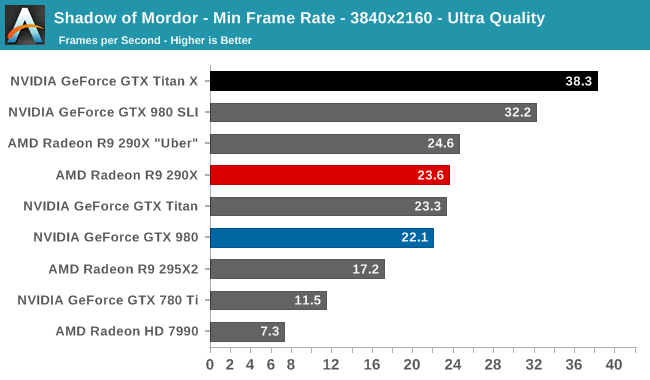

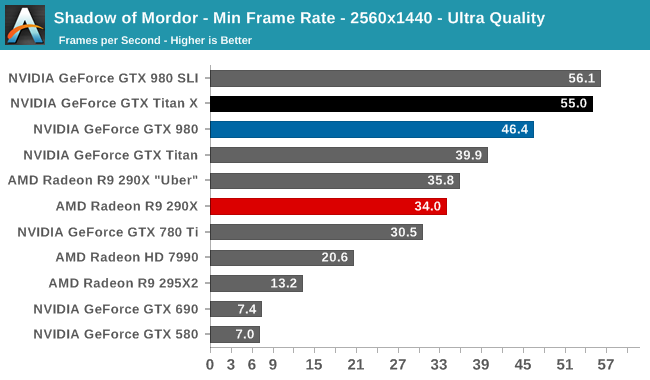
Meanwhile the game’s minimum framerate further elaborates on the performance hit from the game’s high VRAM usage at Ultra quality. 3GB cards collapse here, leaving the 4GB cards and the 6GB original Titan much higher in our charts. Multi-GPU performance also struggles here, even with 4GB cards, reminding us that while multi-GPU setups can be potent, they do introduce performance consistency issues that single-GPU cards can avoid.










276 Comments
View All Comments
joeh4384 - Tuesday, March 17, 2015 - link
Old news.joeh4384 - Tuesday, March 17, 2015 - link
I bet if you overclock the crap out of this, its TDP shoots north of 300 watts.cmdrdredd - Tuesday, March 17, 2015 - link
People buying this don't care about TDP.Kutark - Tuesday, March 17, 2015 - link
Which means even with OC it would still be at or under a 290x. I'm failing to see the problem here.TDP is really only super important for compute cards that will be running for hours on end at 100% load.
FlushedBubblyJock - Thursday, April 2, 2015 - link
I didn't care either, my $800 FX9590 loved 320 watts and my "uber" two niner zeroX loved double dipping that 320 watts, so I converted my carbon arc Linclon 220 welder to handle the AMD juice load and my DVD/RW/DL/LS melted tight to my CM heavy tower and dripped bubbling fire plastic drops through my liquid AMD loop... bye bye overclockshing3232 - Tuesday, March 17, 2015 - link
It does not make anything, because 290x is a old CardStuka87 - Tuesday, March 17, 2015 - link
You can't take those numbers seriously though, as they are wrong. Anandtech is *STILL* using reference cards for these tests. You have not been able to buy reference cards for over a year now. The current cards are run MUCH cooler, MUCH quieter, use less power, and have better performance.Stuka87 - Tuesday, March 17, 2015 - link
Quick edit, it seems XFX is still selling a reference 290X. No clue why, but they are. You can get custom cooled AIB cards for less. Could just be leftover stock though I suppose.Ryan Smith - Tuesday, March 17, 2015 - link
Using reference cards is consistent with our long-standing policy to use them. Aside from the immediate definition of reference, I believe that it is very important not to cherry pick results. The results you in our reviews should be equal to or lower than the results you will get with a retail card - we specifically want to avoid publishing results higher than what the buyer can get.* We don't want to overstate the performance of a card.* Using the same testbed hardware as us of course.
beginner99 - Tuesday, March 17, 2015 - link
Still it shows the 290(x) in a way poorer light than is actually true. At least that should be stated but better would be to add a AIB card to the reviews,